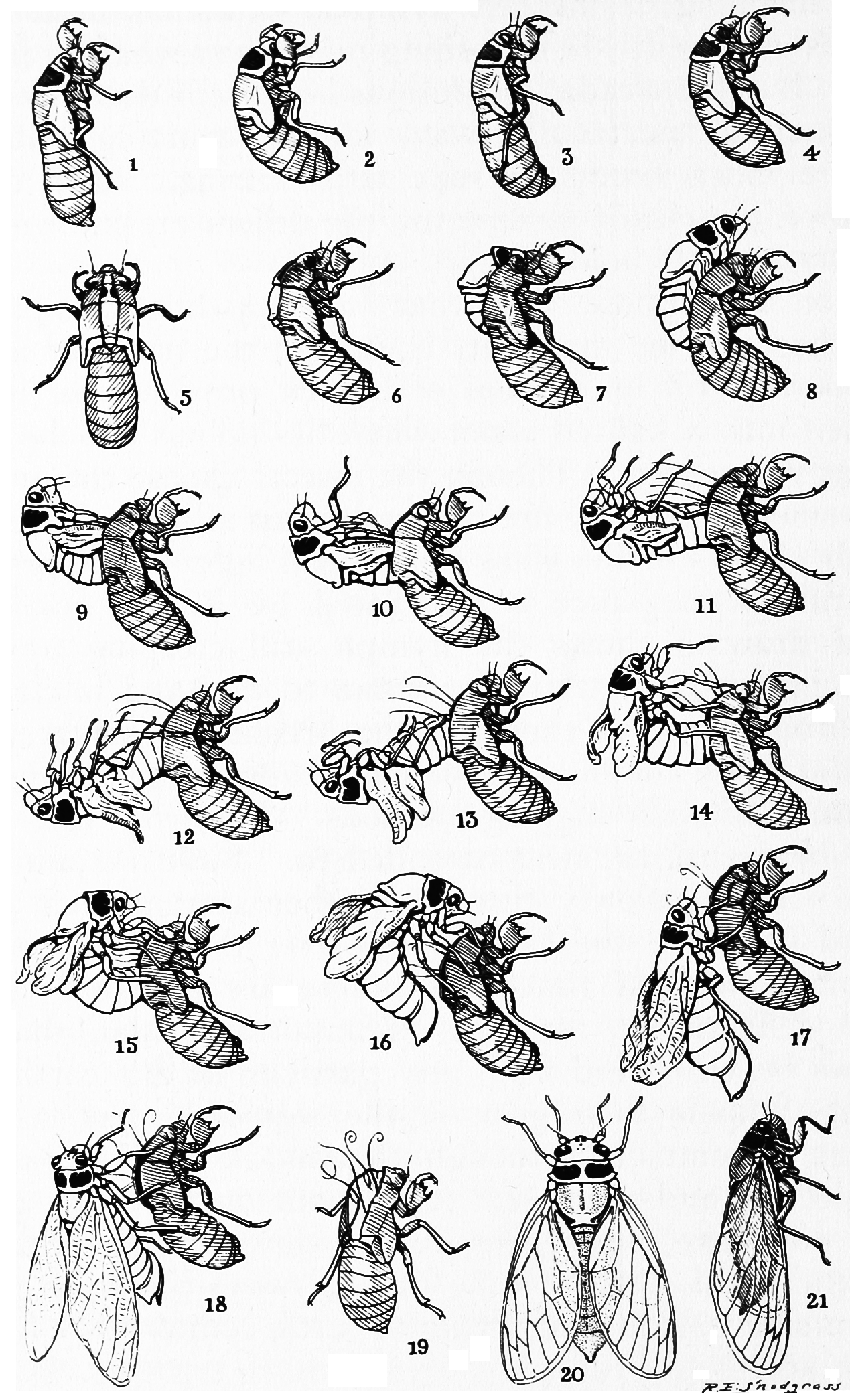|
Magicicada Cassini
''Magicicada cassini'' (originally spelled ''cassinii'' ), known as the 17-year cicada, Cassin's periodical cicada or the dwarf periodical cicada, is a species of periodical cicada. It is endemic to North America. It has a 17-year life cycle but is otherwise indistinguishable from the 13-year periodical cicada '' Magicicada tredecassini''. The two species are usually discussed together as "cassini periodical cicadas" or "cassini-type periodical cicadas." Unlike other periodical cicadas, cassini-type males may synchronize their courting behavior so that tens of thousands of males sing and fly in unison. The species was first reported to the Academy of Natural Sciences of Philadelphia by Margaretta Morris in 1846. In 1852, the species was formally described by J. C. Fisher and given the specific name ''cassini'' in honour of John Cassin, an American ornithologist, whose own report was included by Fisher in his publication. Description The adult ''M. cassini'' is very similar in a ... [...More Info...] [...Related Items...] OR: [Wikipedia] [Google] [Baidu] |
Periodical Cicada
The term periodical cicada is commonly used to refer to any of the seven species of the genus ''Magicicada'' of eastern North America, the 13- and 17-year cicadas. They are called periodical because nearly all individuals in a local population are developmentally synchronized and emerge in the same year. Although they are sometimes called "locusts", this is a misnomer, as cicadas belong to the taxonomic order Hemiptera (true bugs), suborder Auchenorrhyncha, while locusts are grasshoppers belonging to the order Orthoptera. ''Magicicada'' belongs to the cicada tribe Lamotialnini, a group of genera with representatives in Australia, Africa, and Asia, as well as the Americas. ''Magicicada'' species spend around 99.5% of their long lives underground in an immature state called a Nymph (biology), nymph. While underground the nymphs feed on xylem fluids from the roots of deciduous forest trees in the eastern United States. In the spring of their 13th or 17th year mature cicada nymphs em ... [...More Info...] [...Related Items...] OR: [Wikipedia] [Google] [Baidu] |
Nymph (biology)
In biology, a nymph is the immature form of some invertebrates, particularly insects, which undergoes gradual metamorphosis (hemimetabolism) before reaching its adult stage. Unlike a typical larva, a nymph's overall form already resembles that of the adult, except for a lack of wings (in winged species). In addition, while a nymph moults, it never enters a pupal stage. Instead, the final moult results in an adult insect. Nymphs undergo multiple stages of development called instars. This is the case, for example, in Orthoptera (crickets, grasshoppers and locusts), Hemiptera (cicadas, shield bugs, whiteflies, aphids, leafhoppers, froghoppers, treehoppers etc.), mayflies, termites, cockroaches, mantises, stoneflies and Odonata (dragonflies and damselflies). Nymphs of aquatic insects, as in the Odonata, Ephemeroptera, and Plecoptera, are also called naiads, an Ancient Greek name for mythological water nymphs. Usage of the term 'naiad' is no longer popular among entomologists, ... [...More Info...] [...Related Items...] OR: [Wikipedia] [Google] [Baidu] |
Insects Of The United States
Insects (from Latin ') are pancrustacean hexapod invertebrates of the class Insecta. They are the largest group within the arthropod phylum. Insects have a chitinous exoskeleton, a three-part body ( head, thorax and abdomen), three pairs of jointed legs, compound eyes and one pair of antennae. Their blood is not totally contained in vessels; some circulates in an open cavity known as the haemocoel. Insects are the most diverse group of animals; they include more than a million described species and represent more than half of all known living organisms. The total number of extant species is estimated at between six and ten million; In: potentially over 90% of the animal life forms on Earth are insects. Insects may be found in nearly all environments, although only a small number of species reside in the oceans, which are dominated by another arthropod group, crustaceans, which recent research has indicated insects are nested within. Nearly all insects hatch from eg ... [...More Info...] [...Related Items...] OR: [Wikipedia] [Google] [Baidu] |
Insects Of Canada
Insects (from Latin ') are pancrustacean hexapod invertebrates of the class Insecta. They are the largest group within the arthropod phylum. Insects have a chitinous exoskeleton, a three-part body (head, thorax and abdomen), three pairs of jointed legs, compound eyes and one pair of antennae. Their blood is not totally contained in vessels; some circulates in an open cavity known as the haemocoel. Insects are the most diverse group of animals; they include more than a million described species and represent more than half of all known living organisms. The total number of extant species is estimated at between six and ten million; In: potentially over 90% of the animal life forms on Earth are insects. Insects may be found in nearly all environments, although only a small number of species reside in the oceans, which are dominated by another arthropod group, crustaceans, which recent research has indicated insects are nested within. Nearly all insects hatch from eggs. Ins ... [...More Info...] [...Related Items...] OR: [Wikipedia] [Google] [Baidu] |
Hemiptera Of North America
Hemiptera (; ) is an order of insects, commonly called true bugs, comprising over 80,000 species within groups such as the cicadas, aphids, planthoppers, leafhoppers, assassin bugs, bed bugs, and shield bugs. They range in size from to around , and share a common arrangement of piercing-sucking mouthparts. The name "true bugs" is often limited to the suborder Heteroptera. Entomologists reserve the term ''bug'' for Hemiptera or Heteroptera,Gilbert Waldbauer. ''The Handy Bug Answer Book.'' Visible Ink, 1998p. 1. which does not include other arthropods or insects of other orders such as ants, bees, beetles, or butterflies. In some variations of English, all terrestrial arthropods (including non-insect arachnids, and myriapods) also fall under the colloquial understanding of ''bug''. Many insects with "bug" in their common name, especially in American English, belong to other orders; for example, the lovebug is a fly and the Maybug and ladybug are beetles. The term is also occa ... [...More Info...] [...Related Items...] OR: [Wikipedia] [Google] [Baidu] |
Lamotialnini
Lamotialnini is a tribe of cicadas in the family Cicadidae. There are about 19 genera and at least 90 described species in Lamotialnini, occurring worldwide except South America. Genera These 19 genera belong to the tribe Lamotialnini: * '' Abricta'' Stål, 1866 * '' Abroma'' Stål, 1866 * '' Aleeta'' Moulds, 2003 * '' Allobroma'' Duffels, 2011 * '' Chrysolasia'' Moulds, 2003 * '' Hylora'' Boulard, 1971 * '' Lamotialna'' Boulard, 1976 * '' Lemuriana'' Distant, 1905 * ''Magicicada'' Davis, 1925 (periodical cicadas) * '' Monomatapa'' Distant, 1879 * '' Musimoia'' China, 1929 * '' Neomuda'' Distant, 1920 * '' Oudeboschia'' Distant, 1920 * '' Panka'' Distant, 1905 * '' Sundabroma'' Duffels, 2011 * '' Trismarcha'' Karsch, 1891 * ''Tryella'' Moulds, 2003 * '' Unduncus'' Duffels, 2011 * '' Viettealna'' Boulard, 1980 c g - MadagascarBoulard M (1980) Genres nouveaux, espèces nouvelles de cigales malgaches (Homoptera) ''Bulletin de la Société entomologique de France''. 85: 105-110. iet ... [...More Info...] [...Related Items...] OR: [Wikipedia] [Google] [Baidu] |
Entomologist
Entomology () is the scientific study of insects, a branch of zoology. In the past the term "insect" was less specific, and historically the definition of entomology would also include the study of animals in other arthropod groups, such as arachnids, myriapods, and crustaceans. This wider meaning may still be encountered in informal use. Like several of the other fields that are categorized within zoology, entomology is a taxon-based category; any form of scientific study in which there is a focus on insect-related inquiries is, by definition, entomology. Entomology therefore overlaps with a cross-section of topics as diverse as molecular genetics, behavior, neuroscience, biomechanics, biochemistry, systematics, physiology, developmental biology, ecology, morphology, and paleontology. Over 1.3 million insect species have been described, more than two-thirds of all known species. Some insect species date back to around 400 million years ago. They have many kinds of intera ... [...More Info...] [...Related Items...] OR: [Wikipedia] [Google] [Baidu] |
Vanderbilt University
Vanderbilt University (informally Vandy or VU) is a private research university in Nashville, Tennessee. Founded in 1873, it was named in honor of shipping and rail magnate Cornelius Vanderbilt, who provided the school its initial $1-million endowment in the hopes that his gift and the greater work of the university would help to heal the sectional wounds inflicted by the Civil War. Vanderbilt enrolls approximately 13,800 students from the US and over 100 foreign countries. Vanderbilt is classified among "R1: Doctoral Universities – Very high research activity". Several research centers and institutes are affiliated with the university, including the Robert Penn Warren Center for the Humanities, the Freedom Forum First Amendment Center, and Dyer Observatory. Vanderbilt University Medical Center, formerly part of the university, became a separate institution in 2016. With the exception of the off-campus observatory, all of the university's facilities are situated on it ... [...More Info...] [...Related Items...] OR: [Wikipedia] [Google] [Baidu] |
Urban Legend
An urban legend (sometimes contemporary legend, modern legend, urban myth, or urban tale) is a genre of folklore comprising stories or fallacious claims circulated as true, especially as having happened to a "friend of a friend" or a family member, often with horrifying, humorous, or cautionary elements. These legends can be entertaining but often concern mysterious peril or troubling events, such as disappearances and strange objects or entities. Urban legends may confirm moral standards, reflect prejudices, or be a way to make sense of societal anxieties. Urban legends in the past were most often circulated orally, but now can also be spread by any media. This includes newspapers, mobile news apps, e-mail, and most often, social media. Some urban legends have passed through the years/decades with only minor changes, in where the time period takes place. Generic urban legends are often altered to suit regional variations, but the lesson or moral remains majorly the same. Or ... [...More Info...] [...Related Items...] OR: [Wikipedia] [Google] [Baidu] |
Naperville, Illinois
Naperville ( ) is a city in DuPage County, Illinois, DuPage and Will County, Illinois, Will counties in the U.S. state of Illinois. It is in the Chicago metro area, west of the city. Naperville was founded in 1831 by Joseph Naper. The city was established by the banks of the DuPage river, and was originally known as Naper's Settlement. By 1832, over 100 residents lived in Naper's Settlement. In 1839, after DuPage County was split from Cook County, Naperville became the county seat, which it remained until 1868. Beginning in the 1960s, Naperville experienced a significant population increase as a result of Chicago's urban sprawl. As of the 2020 United States census, 2020 census, its population was 149,540, making it the state's fourth-most populous city. Naperville's largest employer is Edward Hospital with 4,500 employees. Naperville is home to Moser Tower and Millennium Carillon, one of the world's four largest carillons. It is also home to an extensive parks and forest prese ... [...More Info...] [...Related Items...] OR: [Wikipedia] [Google] [Baidu] |
Brood XIII
Brood XIII (also known as Brood 13 or Northern Illinois Brood) is one of 15 separate broods of periodical cicadas that appear regularly throughout the midwestern United States. Every 17 years, Brood XIII tunnels ''en masse'' to the surface of the ground, mates, lays egg (biology), eggs, and then dies off in several weeks. Although entomologist Charles Lester Marlatt, C. L. Marlatt published an account in 1907 in which he argued for the existence of 30 broods, over the years a number have been consolidated and only 15 are recognized today as being distinct. Brood XIII is among the 12 different broods with 17-year cycles. Its most recent appearance was in the spring and early summer of 2007, throughout an area roughly enclosed by northern Illinois, eastern Iowa, southern Wisconsin, and a narrow strip of Indiana bordering Lake Michigan and Michigan. It will emerge again in 2024 and 2041. The 4-centimeter long black bugs do not sting or bite. Once they emerge, they spend their shor ... [...More Info...] [...Related Items...] OR: [Wikipedia] [Google] [Baidu] |
Brood X
Brood X (Brood 10), the Great Eastern Brood, is one of 15 broods of periodical cicadas that appear regularly throughout the eastern United States. The brood's first major emergence after 2021 is predicted to occur during 2038. Characteristics Every 17 years, Brood X cicada nymphs tunnel upwards ''en masse'' to emerge from the surface of the ground. The insects then shed their exoskeletons on trees and other surfaces, thus becoming adults. The mature cicadas fly, mate, lay eggs in twigs, and then die within several weeks. The combination of the insects' long underground life, their nearly simultaneous emergence from the ground in vast numbers and their short period of adulthood allows the brood to survive even massive predation. Brood X is endemic in Indiana, Ohio, southeastern Pennsylvania, Maryland, New Jersey, Delaware, East Tennessee, Virginia, Washington, DC, and other areas throughout the eastern United States. The brood contains three species, ''Magicicada septendecim'', ' ... [...More Info...] [...Related Items...] OR: [Wikipedia] [Google] [Baidu] |

.jpg)







.jpg)
